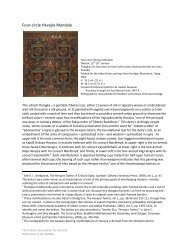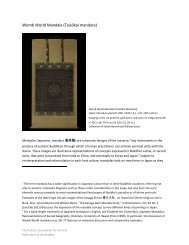Reflections of the Buddha - The Pulitzer Foundation for the Arts
Reflections of the Buddha - The Pulitzer Foundation for the Arts
Reflections of the Buddha - The Pulitzer Foundation for the Arts
Create successful ePaper yourself
Turn your PDF publications into a flip-book with our unique Google optimized e-Paper software.
Gallery Guide & Checklist<br />
Entrance Gallery<br />
Japan: Pure Land Sculpture in <strong>the</strong> 11th & 13th Centuries<br />
Pure Land, a <strong>for</strong>m <strong>of</strong> Mahāyāna Buddhism, venerates <strong>the</strong> <strong>Buddha</strong> Amitābha (<strong>Buddha</strong> <strong>of</strong> Immeasurable Light). One<br />
<strong>of</strong> <strong>the</strong> <strong>Buddha</strong>s <strong>of</strong> <strong>the</strong> Ten Directions, Amitābha presides over a pure <strong>Buddha</strong> realm called “Land <strong>of</strong> Bliss,” which<br />
lies in <strong>the</strong> West. He brings to his realm anyone desiring to be reborn <strong>the</strong>re and aids him or her in attaining enlightenment.<br />
Pure Land became increasingly popular in Japan from <strong>the</strong> eleventh to <strong>the</strong> thirteenth centuries and<br />
inspired many sculptural commissions depicting Amitābha. <strong>The</strong> use <strong>of</strong> wood (<strong>of</strong>ten cypress) and lacquer, along<br />
with a naturalistic treatment <strong>of</strong> <strong>the</strong> body and <strong>the</strong> adoption <strong>of</strong> inlaid rock crystal, became distinctive features <strong>of</strong><br />
<strong>the</strong>se sculptures.<br />
1. Standing Prince Shōtoku at Age Two<br />
(Shōtoku Taishi Nisaizō), c. 1292<br />
Japan, Kamakura period, 1185 – 1333; Japanese<br />
cypress (hinoki) wood; assembled woodblock<br />
construction with polychromy and rock-crystal<br />
inlaid eyes; 26¾ x 9¾ x 9 in.; Harvard Art<br />
Museums / Arthur M. Sackler Museum, Promised<br />
gift <strong>of</strong> Walter C. Sedgwick in memory <strong>of</strong> Ellery<br />
Sedgwick Sr. and Ellery Sedgwick Jr., 99.1979.1<br />
Prince Shōtoku (574 – 622) was one <strong>of</strong> Japan’s earliest followers<br />
and patrons <strong>of</strong> Buddhism. Starting in <strong>the</strong> eleventh<br />
century, new sects <strong>of</strong> Pure Land Buddhism exalted<br />
Shōtoku as an incarnation <strong>of</strong> Śākyamuni. Portraits <strong>of</strong><br />
Shōtoku depicted significant episodes and legends about<br />
his life. This is <strong>the</strong> earliest extant sculpture showing him<br />
at <strong>the</strong> age <strong>of</strong> two, when he reputedly faced east, placed<br />
his palms toge<strong>the</strong>r, and said <strong>the</strong> nembutsu, a Pure Land<br />
Buddhist practice <strong>of</strong> reciting <strong>the</strong> name <strong>of</strong> Amitābha.<br />
2. Left Hand <strong>of</strong> a Colossal <strong>Buddha</strong> Amitābha<br />
(Amida Nyōrai), c. 1202<br />
Attributed to Kaikei, Japanese, active<br />
c. 1183 – 1236; Kamakura period,<br />
1185 – 1333; Japanese cypress<br />
(hinoki) wood with traces <strong>of</strong> lacquer,<br />
polychromy, and gilding; probably from an Amida triad originally<br />
at <strong>the</strong> Shin-Daibutsu-ji Temple in Iga, Mie Prefecture;<br />
10½ x 26¼ x 12 in.; Harvard Art Museums / Arthur M. Sackler<br />
Museum, Gift <strong>of</strong> Charles Bain Hoyt, 1931.9<br />
Scholars recently attributed this hand to a 16-ft. high<br />
Amitābha sculpture commissioned by Monk Shunjōbō<br />
Chōgen (1121 – 1206) and created by <strong>the</strong> master sculptor<br />
Kaikei, both extremely influential cultural figures in <strong>the</strong><br />
Kamakura period. <strong>The</strong> mudrā, or hand gesture, depicted<br />
is one <strong>of</strong> welcoming used by Amitābha to greet <strong>the</strong> dead<br />
into <strong>the</strong> Land <strong>of</strong> Bliss: <strong>The</strong> middle and third fingers curve<br />
inward, with <strong>the</strong> middle one joined to <strong>the</strong> thumb.<br />
3. Standing <strong>Buddha</strong> Amitābha (Amida Nyōrai),<br />
mid-13th century<br />
Japan, Kamakura period, 1185 – 1333; wood with<br />
gold pigment, lacquer, gilding, and rock-crystal<br />
insets; 44⅜ x 20 x 20 in.; Saint Louis Art<br />
Museum, Museum Purchase, 132:1966<br />
In this sculpture, rock crystal helps represent<br />
Amitābha’s emanating light—in his<br />
eyes, at <strong>the</strong> base <strong>of</strong> <strong>the</strong> cranial protuberance<br />
known as usnīsa (a sign <strong>of</strong> expanded and radiating wisdom),<br />
and as <strong>the</strong> ūrnā (<strong>the</strong> third eye on his <strong>for</strong>ehead<br />
indicating spiritual insight and illumination). Although<br />
<strong>the</strong>se are common characteristics <strong>of</strong> <strong>the</strong> Śākyamuni image,<br />
<strong>the</strong> welcoming mudrā identifies <strong>the</strong> image as<br />
Amitābha. Once thought to be <strong>the</strong> work <strong>of</strong> Kaikei—<strong>the</strong><br />
artist <strong>of</strong> <strong>the</strong> colossal hand nearby—this sculpture is now<br />
attributed to a follower from a generation or so later.<br />
4. Head <strong>of</strong> a Celestial Attendant, Presumably Head <strong>of</strong> a<br />
Bodhisattva (Bosatsu) or <strong>of</strong> an Apsara<br />
(Hiten), c. 1053<br />
Attributed to Studio <strong>of</strong> Jōchō, Japanese, died<br />
1057; Heian period, 794 – 1185; Japanese<br />
cypress (hinoki) wood with traces <strong>of</strong> polychromy;<br />
8� x 3� in.; Harvard Art Museums /<br />
Arthur M. Sackler Museum, Promised gift <strong>of</strong><br />
Walter C. Sedgwick in honor <strong>of</strong> John<br />
Rosenfield, 89.1979<br />
This head is thought to be that <strong>of</strong> one <strong>of</strong> fifty-two celestial<br />
attendants that once accompanied a colossal<br />
Amitābha statue at <strong>the</strong> Hōō-dō (Phoenix Hall) <strong>of</strong> <strong>the</strong><br />
Byōdō-in temple in Uji, near Kyoto. Here, <strong>the</strong> sculptor<br />
Jōchō sought to replicate Amitābha’s Land <strong>of</strong> Bliss, where<br />
attendants fly overhead and praise Amitābha by scattering<br />
flowers, playing instruments, and burning incense.




